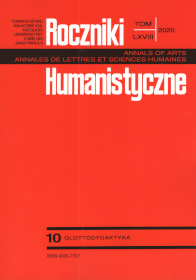Narzędzia cyfrowe w dydaktyce przekładu: Zasoby leksykalne oraz narzędzia korpusowe do edycji tekstu
Abstrakt
Niniejszy artykuł stanowi przegląd zasobów leksykalnych oraz narzędzi korpusowych przydatnych do oceny, edycji oraz weryfikacji przetłumaczonych tekstów. Dodatkowo zawiera opis badania pilotażowego, którego celem było opisanie zachowania studentów w sytuacji, gdy należy ocenić oraz dokonać modyfikacji leksykalno-stylistycznej wyrażenia metaforycznego przetłumaczonego maszynowo. Analizie poddano jedynie to, jakich narzędzi oraz zasobów studenci używali i na jakim etapie zadania. Ćwiczenie zostało wykonane w ramach zajęć na studiach magisterskich, kierunek: przekładoznawstwo – technologie tłumaczeniowe.
Bibliografia
Allen, Jeffrey. „Post-editing”. Computers and Translation: A Translator’s Guide, red. Harold Somers, John Benjamins Publishing Company, 2003, ss. 297-318.
Brożyna-Reczko, Małgorzata. „O metaforze choroby w polskim i angielskim prasowym dyskursie politycznym”. Tekst i Dyskurs, vol. 11, 2018, ss. 351-369.
Cockiewicz, Wacław. Metaforyka Leśmiana. (Analiza lingwistyczna). Wydawnictwo Akademickie, 2011.
Delizée, Anne. „A global rating scale for the summative assessment of pragmatic translation at Master’s level: An attempt to combine academic and professional criteria”. Perspectives on Translation Quality, red. Ilse Depraetere, De Gruyter, 2011, ss. 9-24.
Dobrzyńska, Teresa. Mówiąc przenośnie. Studia o metaforze. Instytut Badań Literackich, 1994.
Dybiec-Gajer, Joanna. „Kompetencje profesjonalnego tłumacza a kształcenie i sukces zawodowy. Model kompetencji EMT z perspektywy polskich tłumaczy w Parlamencie Europejskim”. Kompetencje tłumacza. Tom dedykowany prof. dr hab. Elżbiecie Tabakowskiej, red. Maria Piotrowska, Artur Czesak, Aleksander Gomola, Sergiy Tyupa, Tertium, 2012, ss. 167-193.
Dybiec-Gajer, Joanna. Zmierzyć przekład. Z metodologii oceniania w dydaktyce przekładu pisemnego. Universitas, 2013
Gouadec, Daniel. Translation as a Profession. John Benjamins Publishing Comapany, 2007.
EMT Expert Group. Competences for Professional Translators, Experts in Multilingual and Multimedia Communication. 2009, ec.europa.eu/info/ sites/info/files/ emt_ competences_ translators_en.pdf. Dostęp 30.09.2020.
Koglin, Arlene. „An empirical investigation of cognitive effort required to post-edit machine translated metaphors compared to the translation of metaphors”. The International Journal for Translation & Interpreting Research, vol. 7, nr 1, 2015, ss. 126-141.
Pęzik, Piotr. „NKJP w warsztacie tłumacza”. Narodowy Korpus Języka Polskiego, red. Adam Przepiórkowski, Mirosław Bańko, Rafał L. Górski, Barbara Lewandowska-Tomaszczyk, Wydawnictwo Naukowe PWN, 2012, ss. 301-311.
Pęzik, Piotr. „Paradygmat Dystrybucyjny w Badaniach Frazeologicznych. Powtarzalność, Reprodukcja i Idiomatyzacja”. Metodologie językoznawstwa. Ewolucja języka, ewolucja teorii językoznawczych, red. Piotr Stalmaszczyk, Wydawnictwo Uniwersytetu Łódzkiego, 2013.
Raido, Vanessa Enriquez. Translation and Web Searching. Routledge, 2014.
Sekuła, Justyna. „Kształcenie zawodowych kompetencji tłumaczy tekstów prawnych i prawniczych w ramach studiów podyplomowych”. Comparative Legilinguistics, vol. 25, 2016, ss. 95-108.
TAUS 2010, TAUS the language data network, www.taus.net/academy/best-practices/postedit-best-practices/machine-translation-post-editing-guidelines. Dostęp 2.10.2019.
Copyright (c) 2020 Roczniki Humanistyczne

Utwór dostępny jest na licencji Creative Commons Uznanie autorstwa – Użycie niekomercyjne – Bez utworów zależnych 4.0 Międzynarodowe.





